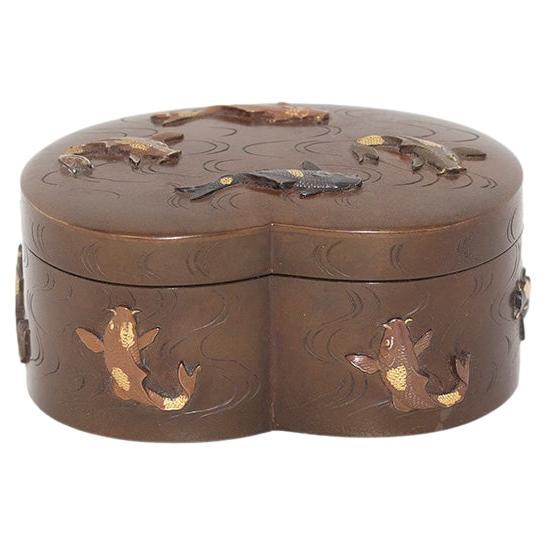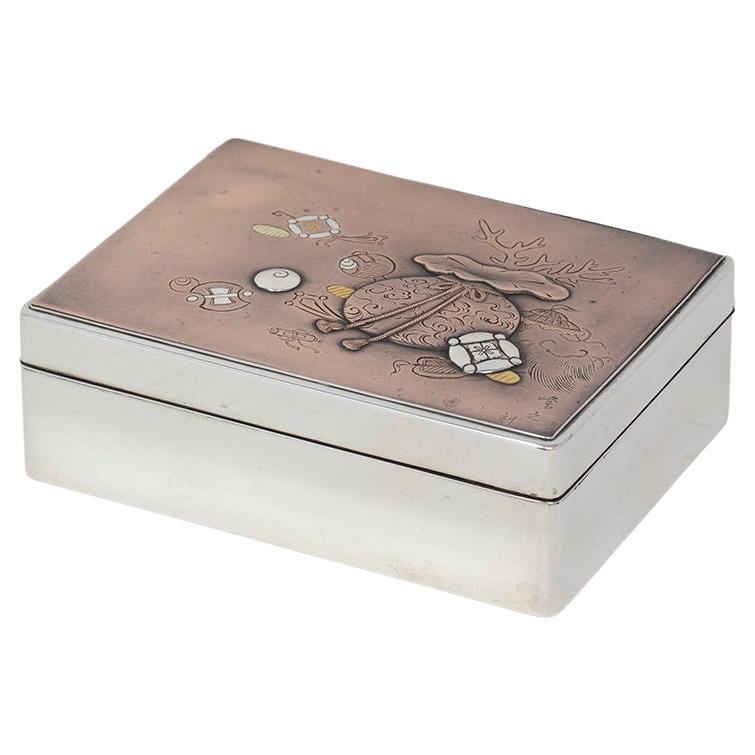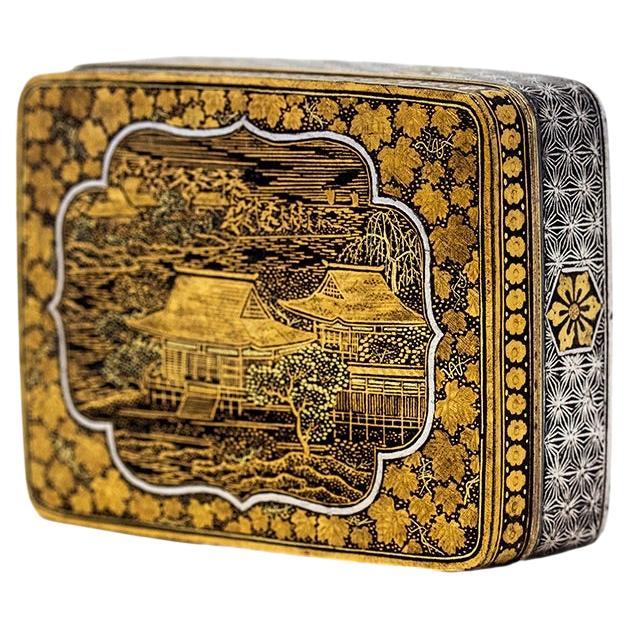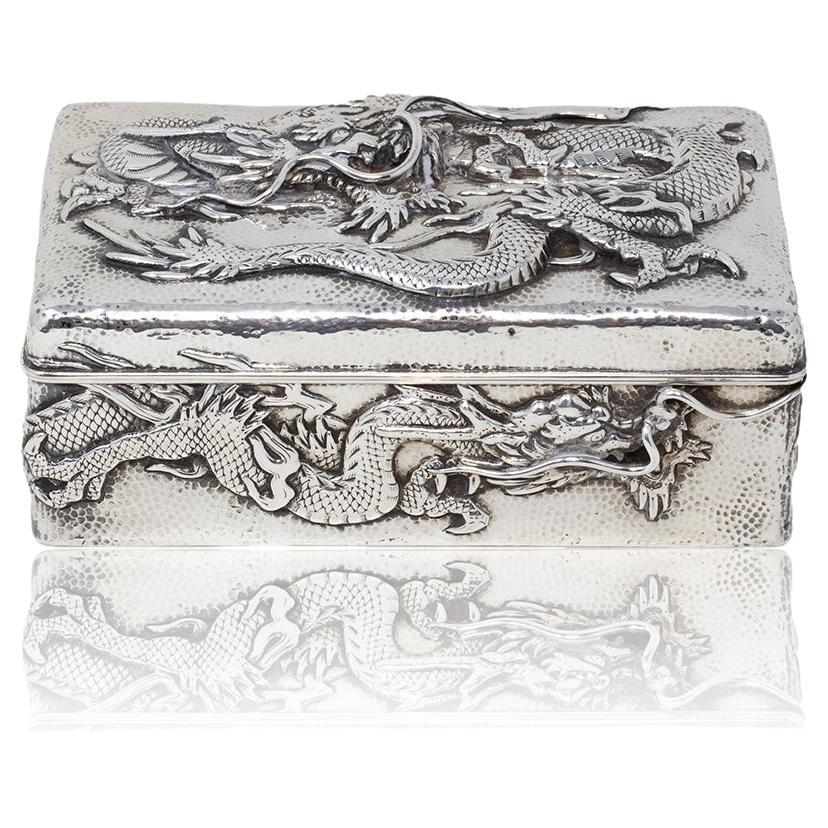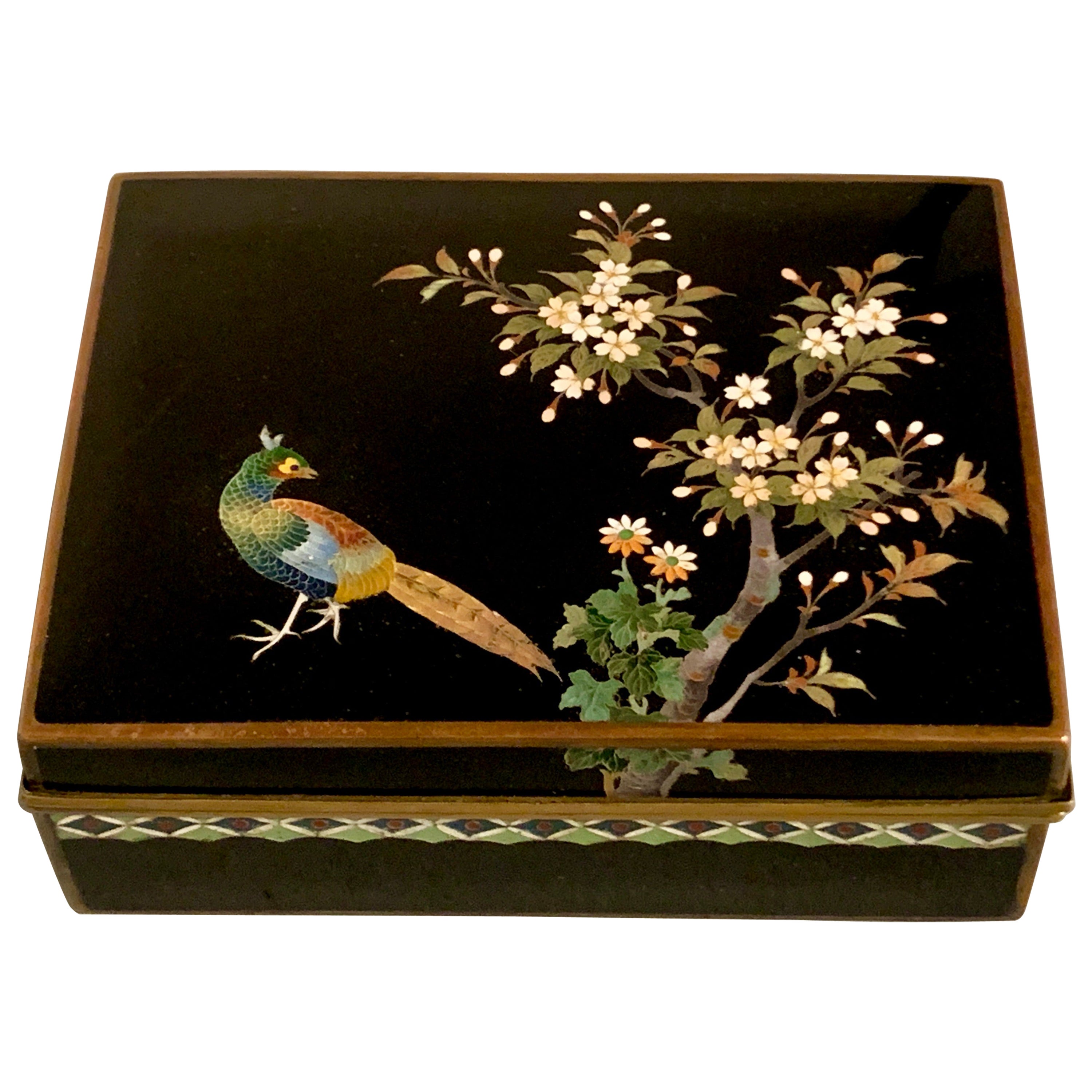Items Similar to Antique Japanese Meiji Period Iron Box
Want more images or videos?
Request additional images or videos from the seller
1 of 21
Antique Japanese Meiji Period Iron Box
About the Item
Meiji Period (1868-1912)
From our Japanese collection, we are delighted to offer this Antique Japanese Meiji Period Iron Box. The Box of slim rectangular form cast in iron and raised upon four tapered feet features a silver and enamel scene to the front with a silver cast Japanese Heron wading through water amongst green enamelled foliage and blossoming flowers. Beside the front scene to the lid an indistinctive two character mark possibly 白代 Hakudai and kao 立 identifies the maker of the box. When opened the box reveals a silver lining with katakiribori (engraving with an angled chisel emulating brushstrokes) decoration with a boat upon a river with multiple birds in front of a mountain signed 義明 Yoshiaki. The Box dates to the late 19th century during the Meiji Period (1868-1912) circa 1890.
Meiji Period was an era of Japanese history that spanned from 1868 to 1912. It was the first half of the Empire of Japan, when the Japanese people began to build a paradigm of a modern, industrialised nation state and emergent great power, influenced by Western countries and aesthetics. As a result of radically different ideas, the changes to Japan were profound and it affected the social structure, politics, economy, military, and foreign relations across the board. The period corresponded to the reign of Emperor Meiji and was preceded by the Keio era and was succeeded by the Taisho era.
Cultural Art during the Meiji Period was of particular interest to the government and they overhauled the art export market which in turn promoted Japanese arts via various world’s fairs, beginning in Vienna at the world fair in 1873. The government heavily funded the fairs and took an active role organising how Japan’s culture was presented to the world including creating a semi-public company named Kiritsu Kosho Kaisha (First Industrial Manufacturing Company). The Kiritsu Kosho Kaisha was used to promote and commercialise exports of Japanese art and established the Hakurankai Jimukyoku (Exhibition Bureau) to maintain quality standards. For the 1876 Centennial International Exhibition in Philadelphia, the Japanese government created a Centennial Office and sent a special envoy to secure space for the 30,000 items that would be displayed. The Imperial Household also took an active interest in arts and crafts, commissioning works by select artists to be given as gifts for foreign dignitaries further emphasising the high quality and importance of Japanese art. Just before the end of the 19th century in 1890, the Teishitsu Gigeiin (Artist to the Imperial Household) system was created to recognise distinguished artists. These artists were selected for their exceptionally high quality wares and talent in their own industry. Over a period of 54 years Seventy artists were appointed, amongst these were ceramicist Makuzu Kozan and cloisonné enamel artist Namikawa Yasuyuki.
Enamel (vitreous enamel) also known as porcelain enamel, is a material made by fusing powdered glass to a substrate by firing, usually between 750 and 850 °C. The powder melts, flows, and then hardens to a smooth, durable vitreous coating. The word vitreous comes from the Latin vitreus, meaning “glassy”.
Antique a collectable object such as a piece of furniture or work of art that has a high value because of its age and quality. Objects of this nature are generally considered antique at 100 plus years of age.
Measurements (centimetres) 3.5cm High x 12cm Long x 8.5cm Wide
- Dimensions:Height: 1.4 in (3.56 cm)Width: 3.35 in (8.51 cm)Depth: 4.7 in (11.94 cm)
- Style:Meiji (Of the Period)
- Materials and Techniques:
- Place of Origin:
- Period:
- Date of Manufacture:1890
- Condition:Wear consistent with age and use.
- Seller Location:Newark, GB
- Reference Number:
About the Seller
5.0
Vetted Seller
These experienced sellers undergo a comprehensive evaluation by our team of in-house experts.
Established in 2019
1stDibs seller since 2022
18 sales on 1stDibs
Typical response time: 3 hours
- ShippingRetrieving quote...Ships From: Newark, United Kingdom
- Return PolicyA return for this item may be initiated within 14 days of delivery.
More From This SellerView All
- Japanese Meiji Period Koi Carp Bronze BoxLocated in Newark, EnglandJapanese meiji period mixed metal box. The box formed in a kidney shape decorated with swimming koi carp fish throughout. Each koi with intricate detailing wi...Category
Antique Early 1900s Japanese Meiji Metalwork
MaterialsMetal, Gold, Bronze
- Japanese Meiji Period Silver Box Signed MasayukiLocated in Newark, EnglandJapanese Meiji period silver box with shibuichi plaque dating circa 1900. The box of rectangular form with a silver polished case stamped Jungin (J...Category
Antique Early 1900s Meiji Metalwork
MaterialsSilver
- Japanese Meiji Period Komai Style Damascene BoxBy KomaiLocated in Newark, EnglandFine Japanese small mixed metal lidded box. The box of excellent quality with a central riverside scene to the lid with a silver wire boarder separating an outer boarder with leaves....Category
Antique Late 19th Century Japanese Meiji Metalwork
MaterialsIron, Metal, Gold, Silver, Brass
- Japanese Meiji Period (1868-1912) Silver Dragon BoxLocated in Newark, EnglandHammered Silver Decoration Stamped Jungin Pure Silver 純銀 From our Japanese collection, we are pleased to offer a Japanese Meiji Period Silver Dragon Box...Category
Antique Late 19th Century Japanese Meiji Metalwork
MaterialsSilver
- Japanese Meiji Period (1868-1912) Three Wise Monkeys Box Komyo 光明Located in Newark, EnglandThe Silver box of rectangular form with rounded corners features the Three Wise Monkeys to the front, see no evil, hear no evil and speak no evil. The monkeys cast beautifully with n...Category
Early 20th Century Japanese Meiji Metalwork
MaterialsSilver, Enamel
- Japanese Bronze Vase Pair Meiji PeriodLocated in Newark, EnglandA fine large sized pair of Japanese bronze vases. The vases each surmounted by waisted necks flanked by two spreading handles with accents in the form of Japanese Torri (traditional ...Category
Antique Late 19th Century Japanese Meiji Metalwork
MaterialsMetal, Gold, Silver, Bronze, Copper
You May Also Like
- Japanese Cloisonne Box, Meiji Period, Late 19th Century, JapanLocated in Austin, TXA very fine and intricately decorated Japanese cloisonné box and cover, Meiji period, late 19th century, Japan. The lidded trinket or jewelry...Category
Antique 1890s Japanese Meiji Metalwork
MaterialsBrass, Copper, Enamel
- Japanese Cloisonne Box by Inaba, Meiji Period, circa 1900, JapanBy Inaba Cloisonne Co.Located in Austin, TXA fine Japanese cloisonne hinged box with pheasant and autumn foliage, by Inaba Nanaho and the Inaba Cloisonne Company, Meiji period, circa 1900, Japan. The lovely jewelry or trin...Category
Antique Early 1900s Japanese Meiji Metalwork
MaterialsCopper, Enamel, Metal
- Meiji Period Japanese Silver CenserLocated in New Orleans, LAThis stunning Meiji period silver censer is a work of exquisite detail. Crafted by renowned silversmith Masatoshi of Tokyo, the censer, or incense burner...Category
20th Century Japanese Meiji Metalwork
MaterialsSilver
- Japanese Meiji Period Cloisonne BowlLocated in Hamilton, OntarioJapanese Meiji period cloisonne bowl.Category
Antique 19th Century Japanese Meiji Metalwork
- Japanese Meiji Period Hand MirrorLocated in Sharon, CTMeiji period cast bronze hand mirror. Very fine casting quality depicting typical Japanese motifs.Category
Antique Late 19th Century Japanese Meiji Metalwork
MaterialsBronze
- Large Japanese Cloisonné Enamel Dish, Japan Meiji periodLocated in Saverne, Grand EstBronze and cloisonné enamel dish very finely decorated with an egret in flight above various flowers on a background of copper inclusions and gold powder. The wing decorated in parti...Category
Antique Late 19th Century Japanese Meiji Metalwork
MaterialsBronze
Recently Viewed
View AllMore Ways To Browse
Antique Swedish Display Cabinets
Oak Dining Suite
Oval Wood Marble Coffee Table
Brown Leather Vase
Orrefors Blue Glass Lamps
Stereo Cabinet Stereo
Putti Brass
Frank Traies
Caldwell Bronze Chandelier
Storage For Log
Vintage Dark Brown Pottery
Vintage Gold Candy Dish
Console Classic With Drawers
Writing Desks White Marble
1950s Kitchen Table And Chairs
Mahagony King Bed
Small Table Lamp Los Angeles
Foldable Serving Trolley
